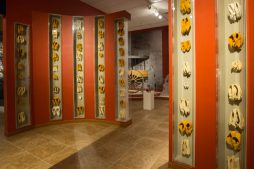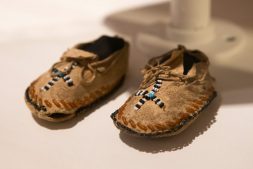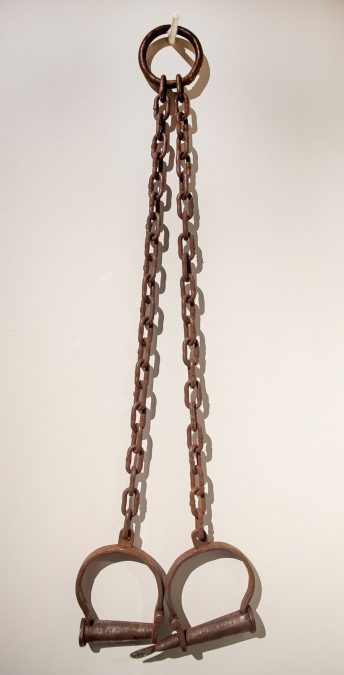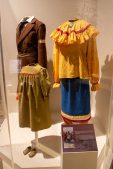
Amidst an era of increased expansion by non-Native settlers into the United States’ western frontiers, a single piece of legislation codified federal policy on the topic of removing tribal people from their lands. On May 28, 1830, President Andrew Jackson signed the Indian Removal Act into law. This legislation authorized the federal government to forcibly relocate Native Americans from their ancestral lands to reservations west of the Mississippi River. On Sept. 4, 1838, the Potawatomi began their involuntary 660-mile walk from present-day Indiana to present-day Kansas known as the Trail of Death. The Forced from Land and Culture – Removal gallery within the Citizen Potawatomi Nation’s Cultural Heritage Center highlights this tumultuous time in the Tribe’s history.
“In the immediate years after the Indian Removal Act, each community was approached the treaty process with the knowledge that something was going to happen,” said Kelli Mosteller, Ph.D., Citizen Potawatomi Nation Cultural Heritage Center’s director.
“The tribal leaders signed treaties. They tried to make it work. They tried to make amends and build a relationship with the government. They were essentially saying, ‘Okay, you can have some lands, but you cannot have it all,’” K. Mosteller said. “As the government kept coming for more and more, as the pressure began to build, the tribes began to lose their patience.”
Chief Menominee led a resistance group of Potawatomi who refused to cede what little lands remained. Records indicate Menominee’s village grew from four wigwams in 1821 to around 100 wigwams and cabins by 1838.
“The question on whether or not there was a treaty that would force our ancestors to remove was being debated,” K. Mosteller said. “Menominee and other village leaders had signed onto a treaty a few years previously that did not call for removal. It was a land cession treaty, and it specifically gave them the right to stay on their assigned reservation lands in Indiana.”
Federal officials called a meeting with the Potawatomi in the village’s church. Many in the Tribe saw this as an opportunity to tell the government that the Great Lakes region was their home and that they were not leaving, she said.
“The leaders weren’t given that opportunity, though,” K. Mosteller said. “When they went into the church, the doors were locked. Three days later, everyone was rounded up. They had a volunteer militia of young men from around the area to ride out and gather up all the Potawatomi who hadn’t gathered at Menominee’s village.”
U.S. General John Tipton’s men also burned the crops and wigwams, which made it difficult for the Potawatomi to stay.
“The federal government, which is organizing this with the politicians in Indiana, knew that they didn’t care what Menominee, Pepinawa, Black Wolf and all these other Tribal leaders said,” K. Mosteller said. “They were going to get them out one way or another — whether it was through convincing or force.”
Wall of moccasins
Records show that most individuals removed during the Trail of Death lacked the proper footwear needed to make the journey. The gallery begins with a display of moccasins to recognize and honor the Potawatomi who endured the 660-mile trail.
CHC employees worked with CPN’s Public Information to encourage Tribal members nation-wide to help make the moccasins. Each pair represents 10 people who walked the Trail of Death.

“The moccasins add a human element to it, especially when you start seeing the baby moccasins —the different sizes and styles,” said Blake Norton, CHC curator. “As you could tell, everybody was pretty unique on these journeys, but everybody kind of shared this experience, as bad as it was.”
Participants received a moccasin kit with all the leather and tools needed, written instructions and a step-by-step video.
“The moccasin project was a really big community-building project,” Norton said. “For most people, I think this was the first time that they had ever made moccasins. It is really neat to see them put their own style and their different spin on it.”
Lowell Ziegler, a CPN member from Garner, North Carolina, and his family contributed to the project.
“While working on the moccasins, I kept thinking about the ones who were forced to march,” Ziegler said. “The ones who had to leave their homes, suffering harsh conditions and facing sickness were a lot tougher than most people today.”
In 1997, Ziegler learned he is Potawatomi and a Burnett family descendant. A few years later, he visited Oklahoma and CPN.
He looks for ways to stay involved with the Nation, even thousands of miles away.
“I have often read articles about the Trail of Death. Not knowing my roots until later in life, I wanted to be able to do something to connect with my heritage,” he said. “This seemed like a good opportunity. I told my daughter, Jordan Dufresne, and she participated as well.”
Ziegler read the instructions provided and watched the tutorial video. He then recruited his son to help create the pattern.
“Making the moccasins was not complicated, but the process took a little longer than expected,” Ziegler said. “It was rough on the fingers, and I broke one of the needles that was included in the kit. I worked hard to try to keep everything as clean as possible while working on them.
“I feel honored to have been allowed to participate and to have my moccasins on display,” he said.
K. Mosteller said this project was an opportunity for CPN members to honor their ancestors and have a hand in the CHC’s reconstruction.
“They like coming to the CHC and being able to point out something they made for the museum — it’s something to be proud of and to bring your family to,” she said.
The Holocaust Museum in Washington D.C. helped inspire the gallery’s design.
“We saw all of the effects that were collected from prisoners in the concentration camps, and they have them on display,” Norton said. “They’re exhibited in a really visceral way, so we wanted to do something similar.
“There’s a small amount of intricate detailing that’s very defining, and this display exhibits what the moccasins signify and the gravity of each pair,” he said.

660-mile trek
“We just wanted to utilize as much of the collection as possible,” Norton said, as he motioned to the moccasins featured on the gallery’s floor. “The moccasins are a common theme here, and the messages that are conveyed in the gallery – we set them up as a procession that leads you through this period into Kansas. It provides a deeper metaphor.”
The moccasins encourage visitors to take time in this exhibit by walking throughout the section, K. Mosteller said.
“Our ancestors were making this long, 660-mile walk away from the homelands and an environment they understood. The oral traditions said that Creator meant for them to be in this place. They were being forced out of that to a place they do not understand; a place where clan animals do not live, the medicines do not grow, there aren’t as many rivers, and there aren’t trees,” she said. “Their whole world was turned upside down.”
The lack of access to clean water on the Trail of Death caused many to die from typhoid and cholera, she said.
“People were sick and probably going to die because they didn’t have medicine or the ability to rest,” K. Mosteller said. “This was not a well-organized removal. The health and wellness of the tribal members were not the government’s concern.”
Under the direction of General John Tipton, federal officials placed Menominee and other leaders in prisoner chains and a jail wagon.
CHC staff strategically placed a display case with shackles and a gun across from a wagon.
“It’s jarring, but it’s also humbling,” K. Mosteller said. “There’s one thing to be told it was a forced removal, and it’s another to stand in front of chains and think about them going on your wrists or the wrists of your grandfather who probably couldn’t walk the 660 miles.”
Mskwa (It is red)
“When we were laying out what colors every section was going to be, one of the first ones that we did not have to discuss was the removal gallery,” K. Mosteller said. “We knew that this section was going to be red.
“Red, whether you like it or whether you hate it, it’s not a neutral color. We chose this particular shade of red for many reasons. It fits in with cool but bold overall color tone that we chose for the CHC,” she said.
“Does it evoke death? Yes, that’s what red does. That is a cross-cultural understanding and concept of red. There are other countries that have more defined understanding of what red means, but in virtually every culture, red has a very intentional connotation tied to it.”
Pick Your Path interactive
In this removal treaty era, different communities had varying responses, K. Mosteller said.
“There were no good choices,” she said. “Some wanted to fight, and some wanted to resist in a more political kind of way by making alliances. Some didn’t want to deal with the government, and they didn’t trust them. They were moving ahead and going somewhere they thought they could be safe and live their lives on their terms without having to deal with the government trying to come in.”
The Pick Your Path Interactive provides scenarios each Potawatomi group faced and allows CHC visitors to select what decisions they would have made based upon the information given. The interactive helps build a greater understanding of the complexities Teach Potawatomi group faced and learn about how the different Potawatomi communities came to exist.
“Putting the interactive as the first thing you see after the moccasins is a good transition,” K. Mosteller said. “Treaties have consequences, and there were a lot of different results.”

Kee-Waw-Nay
A colored George Winter painting wraps the wall behind the interactive and features tribal delegates and several Citizen Potawatomi ancestors at a meeting near the Potawatomi village of Kee-Waw-Nay.
“What’s really neat about the mural is that it works hand in hand with the interactive,” Norton said. “There’s so much acute detail seen in the painting that you can see which individuals are participating in the removal negotiations and know what villages they come from. It helps illustrate how villages came together for these important meetings. It sets the scene as to the way meetings of this type would occur and what each representative looked like. They would have come in their Sunday best.”
This painting also provides insight into traditional regalia.
“This is a case study into the various forms of dress and how people put their own style into things,” K. Mosteller said.
English artist George Winter documented meetings between various tribal leaders and the federal government and followed the Potawatomi on the Trail of Death.
“Once word spread he was at many live negotiations and captured images, people began to commission him to create and report on these meetings — they wanted to remember it,” K. Mosteller said.
George Winter
As a trained miniaturist, many of Winter’s works feature intricate details within a small space. The middle of the exhibit features an interactive where visitors can see his sketches and learn about the Potawatomi depicted in them.
“I think having an artist who was in the place, in the time, and with the people sketching real scenes — that’s something that most tribes do not have. Being able to showcase these pieces, it’s a real boon to us to have these visual representations,” K. Mosteller said. “Of course, every artist is going to put their own interpretation on things, so we can’t take everything in the sketches as gospel.”
The way individuals chose to present themselves to an artist and the artist’s rendering can provide a tremendous amount of insight, she said.
“It says a lot about the relationship and how these individuals carried themselves — their entire persona,” K. Mosteller said. “I think we would be doing a disservice to Tribal members to not highlight Winter’s works and to make it available to them to have that key point of reference.”
No other tribe has first-hand visual records of their removals, Norton said. “To have that record, be able to see each scene and understand what was going on, it’s impactful.”

CHC staff chose several of Winter’s sketches to feature throughout this section and along the walls. They collaborated with CPN graphic designer Trey DeLonais to create layers and depth.
“My process started with high-resolution scans and images, as high as I could get, so the final result was as crisp as possible,” DeLonais said. “The higher resolution images also make cutting them out easier.”
DeLonais placed the images in editing software to select plants and individuals from Winter’s sketches.
“I love the use of these cutouts in the museum, particularly in the removal gallery,” he said. “I think it’s a simple but effective way to bring attention to specific elements while also adding depth.”
Regalia
Staff recruited seamstress and Tribal member Gayla Mosteller to assist with creating regalia featured at the end of this gallery.
“It’s a mixture of pieces from the collections that have been either acquired by us or donated to us over time and then pieces that (Gayla) recreated to make a complete outfit,” K. Mosteller said.
While researching archives in Washington D.C., Norton and K. Mosteller came across a green Potawatomi boy’s dress from Kansas. They captured pictures and began working with G. Mosteller to recreate the piece and find appropriate fabric.
“There’s a Civil War line of quilting fabric, and I was able to find almost the exact same pattern as the dress in the archives,” G. Mosteller said. “The original was pretty tattered, but I was able to recreate the dress really close to the original. I even had the red Rick Rack on hand.”
G. Mosteller said every time she walks through the removal gallery, she feels an ancestral presence.
“I can hear our ancestors laughing, crying and moaning in pain,” G. Mosteller said. “I can be walking in the section from either end, and every time, there’s no denying I can hear and feel them.”
G. Mosteller hopes her pieces encourage members to think about their own regalia.
“Whether it’s ceremonial regalia or like the simple yellow camp dress on display, I hope Tribal members are inspired to create their own pieces,” she said.
Long-term implications
In the end, more than 40 Potawatomi, mostly children and elders, died on the Trail of Death.
“The physical removal is one trauma. The severing from the grounding of our homeland and all of the things that are entwined in that was a secondary trauma that I believe is much longer lasting,” K. Mosteller said. “It carries down through multiple generations — even those generations who were not themselves
on that removal. They had to figure out how to live in the Great Plains as
a woodland people.”
